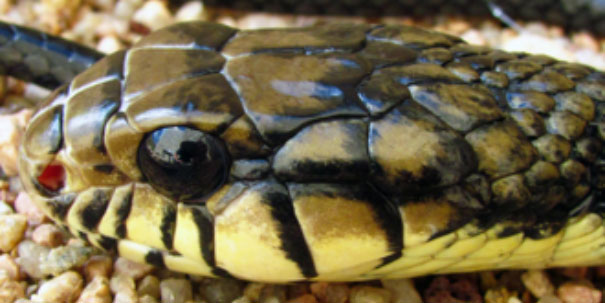
A study by University of Northern Colorado Professor Stephen P. Mackessy and his colleagues including a graduate research assistant identified two toxins in the venom of a species of snake that affect prey differently.
“These new toxins are not only two of the most abundant venom proteins, but are also functionally intriguing, displaying distinct prey-specific toxicities,” Mackessy and his colleagues stated in an abstract for the study published Aug. 1 by The Royal Society’s flagship biological journal Proceedings B.
Above: The Amazon Puffing Snake uses multiple toxins in its venom to capture prey, a team of UNC researchers discovered.
The toxins, named sulditoxin and sulmotoxin 1 by the UNC researchers, were discovered in the Amazon Puffing Snake as part of Mackessy’s ongoing research exploring the evolution of venoms. Sulditoxin is “highly toxic” toward lizard prey but harmless to mammals such as rodents. Sulmotoxin 1, on the other hand, is the opposite.

Mackessy
“This is the first case in which a bimodal and contrasting pattern of toxicity has been shown for proteins in the venom of a single snake in relation to diet,” according to the study.
“Looking at animal venoms and understanding the mechanisms of how some of these toxins work actually provides us insights into how our own systems work, and also are a possible source of new therapeutic drugs,” Mackessy told Newsweek.
The article, titled “Adaptive evolution of distinct prey-specific toxin genes in
rear-fanged snake venom,” appears on the Proceedings B website. Mackessy co-authored the article with Cassandra M. Modahl (as part of her UNC dissertation),
Seth Frietze, a former UNC biology faculty member and Mrinalini from National University
of Singapore.
Mackessy, who has published over 100 scientific works, is a foremost authority and
sought-after expert on venomous snakes and their venoms. In addition to venom evolution,
Mackessy studies venoms for possible cancer treatment in humans. He hosts visiting
scientists from around the world, and he involves undergraduate and graduate students
in his research.
For more information, visit his lab page.
More Stories
-
Daniel Garza’s Journey from Platteville, Colorado, to Stellenbosch, South Africa
Este artículo no está en español.
-
Crafting a Home Field Experience
Este artículo no está en español.
-
Doctoral Candidate Tackles Social Issues Using Data Science
Este artículo no está en español.
-
Bridging the Gap Between High School and College: Frontiers of Science Institute
Este artículo no está en español.





